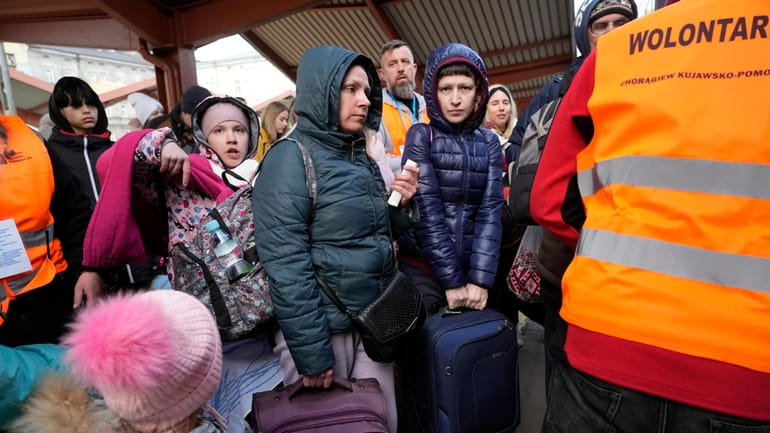Ukraine's refugees face a tragedy not of their making

Refugees with children board a train after fleeing the war from neighboring Ukraine at a railway station in Przemysl, Poland, on Friday. Credit: AP
What do the concrete skeletons of Ukraine tell us about the future of the people who once lived and worked in them?
We see the rows of ravaged hulks in city after city scroll across our TV screens, and they haunt us. Imagine how they must wound the Ukrainians.
So many residents are gone now. Some 10 million Ukrainians have been displaced; that’s about a quarter of the population. Some 3.5 million of them have left the country. Most astonishing, more than half of Ukraine’s children have fled their homes. That’s roughly 4.3 million kids, ripped from the places they live, often separated from at least some of the family they love, in the one month since Russia began its despicable invasion.
It’s the biggest refugee crisis in Europe since World War II, according to the UN and U.S. Secretary of State Antony Blinken.
So far, much of the world — especially the countries that ring Ukraine — has responded magnificently. Poland has taken more than 2 million refugees. Tiny Moldova has accepted more than 100,000 — 1 for every 26 Moldovans. President Joe Biden has pledged to welcome 100,000 Ukrainians.
Each of these literally lost souls is in crisis. Almost overnight, they have transformed from people of self-determination making their way through life and planning their futures to people dependent on the kindnesses of strangers.
But empathy is not endless, as history tells us. And the costs of housing, food, health care, and education are substantial. Homes are open to Ukrainians now, and funds and supplies are pouring in now, but for how long? Already, some Polish cities are sounding alarms. Add to that another lesson of the ages: We humans eventually move on, though the circumstances of this war and the identity of its instigator and his unrelenting cruelty and the hour-by-hour coverage of the mounting catastrophes might keep us involved somewhat longer than usual.
But the larger and tougher and longer-term question is not whether the world will continue to welcome the Ukrainians but whether the Ukrainians will want to be welcomed. In other words, will they prefer simply to go home?
You hear that desire expressed now by countless bewildered refugees crossing foreign borders to safe havens who cannot process what has happened to them. Adults and children alike, they want what they knew — the families, friends, streets, schools, playgrounds, stores, libraries, museums, concert halls, and parks that make up the entirety of what we mean when we say “home.”
But in many cases, they have no actual home to which to return. All of those building blocks are gone.
When a cease fire comes, the rebuilding challenges will be monumental. The cost will be in the many billions. The time frame will be years, if not decades. Talk of a Marshall Plan for Ukraine has started — once the war is over.
But even when the bombs and bullets stop falling and firing, the war won’t be over. Its malignancies will ripple. The longer the war lasts, the more it will strain the ties of Ukrainians to their homeland. Over time, some will find some measure of peace and even happiness in their new abodes. Some will feel trepidation about returning to any place where Vladimir Putin might still perch across the way, his lingering glare backed by tanks.
But for some, likely for many, perhaps for most, their passion and resolve will overtake their sense of his cruelty. And they will return. And rebuild. And reestablish the sense of home from which they were so swiftly severed.
There is now a vast Ukrainian diaspora. Coming home would be their biggest victory of all.
Columnist Michael Dobie’s opinions are his own.

